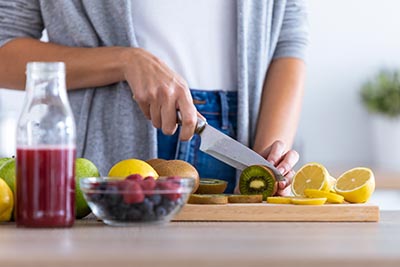
What kind of wood should I use for cutting boards? Fruit and nut-producing hardwoods are ideal for cutting boards because they are robust, non-porous, and firm. Cutting boards made from maple, teak, walnut, and beech are long-lasting and attractive. Avoid woods like soft pine, which are susceptible to mold and warping because of their porous nature. A gorgeous bamboo cutting board might cause blades to dull more quickly than other kinds of wood.
Making a cutting board requires 8 items
You’ll need some basic woodworking supplies and equipment to create a DIY chopping board at home. To construct your own cutting board, these are the materials you’ll need. And there is no matter which kind of cutting board you are going to make: small, medium, or even extra large cutting board like this one:
- Various pieces of non-porous hardwood will be needed to build your cutting board. Several 1.5-inch square sticks will be glued together to form a cutting board.
- To keep the wood pieces together, you’ll need wood glue.
- Cutting tools: You’ll need a table saw and miter saw.
- As the wood dries, use rod clamps to keep it all in place.
- You’ll need a manual planer to get the cutting board to a consistent thickness and smoothness with this.
- A sandpaper: You will need this when you finish sanding the surface of the cutting board.
- In order to prevent your cutting board from any food or bacterial contamination, you’ll need edible mineral oil.
- Glasses and gloves are required for safety reasons. Having safety glasses and gloves on hand when working with wood is a good idea to keep your hands safe from cuts and your eyes protected from wood dust or debris.
A step-by-step guide on how to build a cutting board
Make your own wood grain chopping board by following these simple step-by-step instructions.
The wood should be prepped. Using safety goggles and gloves, feed 1 12″ thick and 16″ long pieces of wood waste through a planer until they are perfectly smooth. To build your pattern, use distinct or identical pieces of wood, depending on the design you chose. In order to cut and sand without compromising the final surface area, plan to make your board slightly bigger than the needed size.
Submissions are open. The strips should be arranged in a row. To create a design that you like, experiment with various wood textures and colours. Before putting the board together, here is your last opportunity to make changes to the design.
Apply glue to the boards. Placing a piece of newspaper beneath your desk while you finish your design can help keep the area looking tidy. A glue brush may be used to apply a thick layer of wood glue to the inside of the wood pieces. To remove excess glue, use clamps to hold the pieces you just bonded together. Then wipe the surface with a moist cloth. Overnight, let the board dry out in the open air.
Cut the board into the form you want it to be. Remove the clamps when the board is dry and the glue has been scraped off. When working with uneven boards, you may use a band saw or jigsaw to trim the edges. Round edges may be achieved by making circles around the edges of the board and then cutting the ends at right angles.
The final board should be sanded, lubricated and processed. You should pick a wood finish that penetrates the grain of the wood rather than merely protecting it from the elements after you’ve sanded the board. Before applying beeswax, first apply edible mineral oil (or liquid paraffin oil) on the board.
The following are four recommendations for maintaining your cutting board
- Cutting boards and butcher block countertops may be cared for in the same way. Your cutting board can last a long time if you take proper care of it.
- After each usage, properly clean the board. It’s best not to use a dishwasher to clean your cutting board. To avoid warping, avoid soaking the board in warm water and always dry completely with a clean cloth or paper towel. However, this is not essential and may discolor your wash over time if you use a moderate, food-safe bleach solution.
- Lemon juice is an effective deodorizer. Rub the board with a combination of baking soda and lemon juice if it begins to smell. Lemon juice or white vinegar may also be used to clean a cutting board.
- Instead of using oils, use wood conditioner. Using vegetable oil to cure a cutting board is a waste of time and money, so use wood conditioner instead.
Story by Jane Austen










